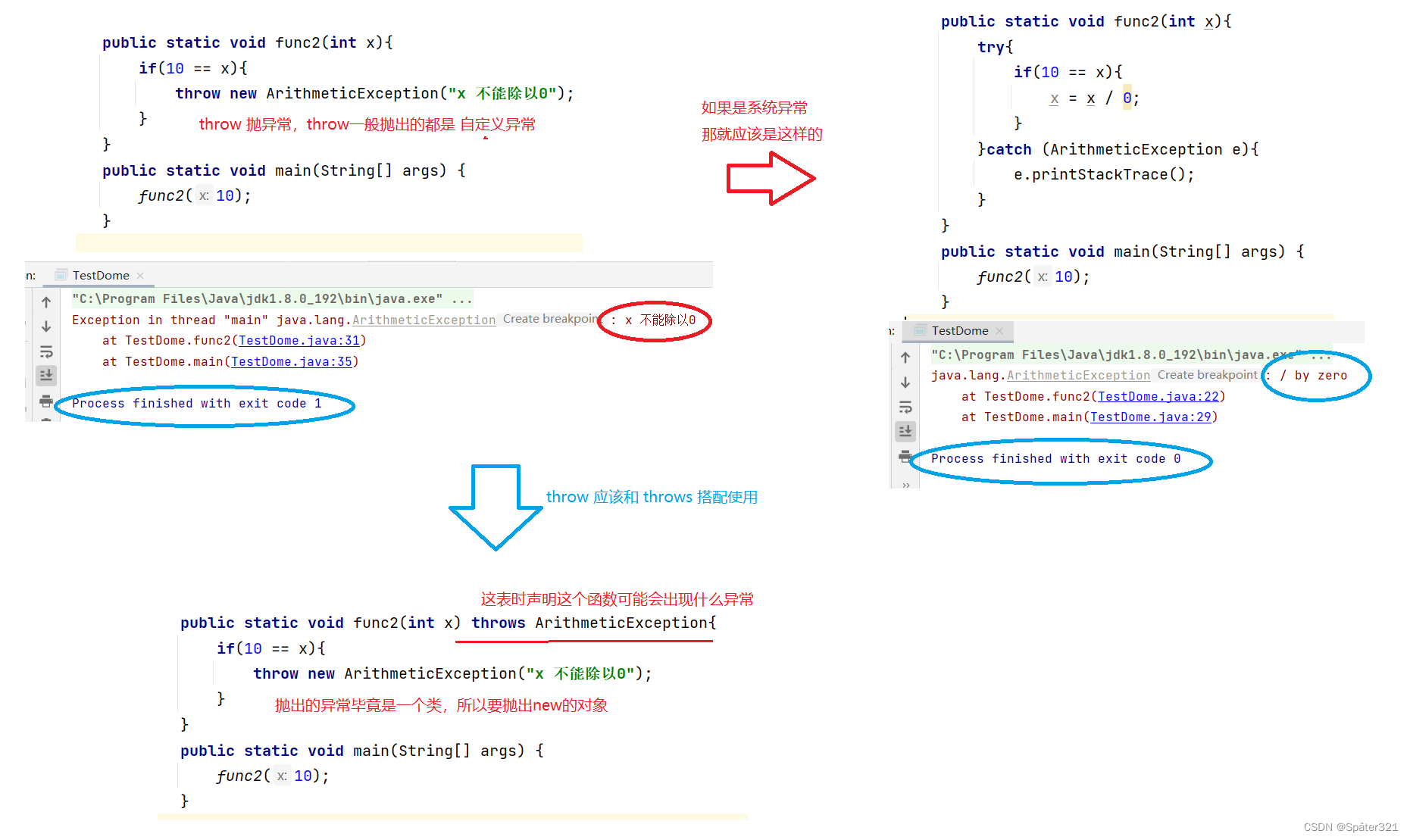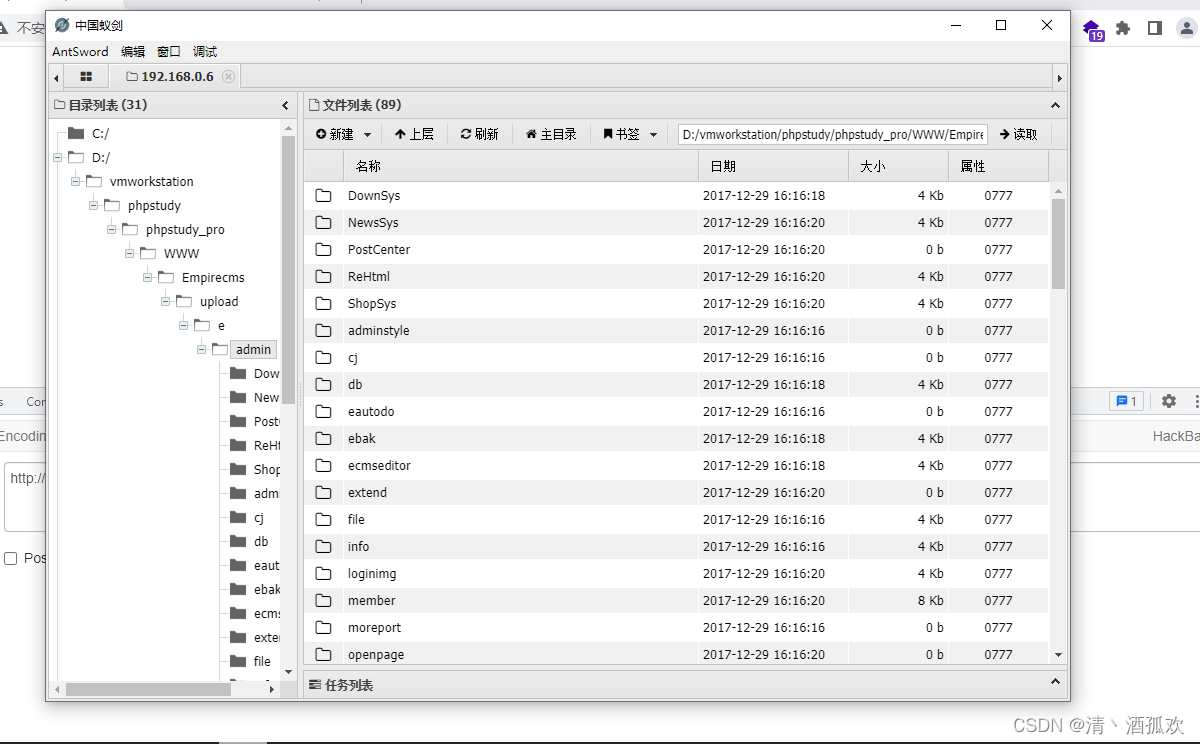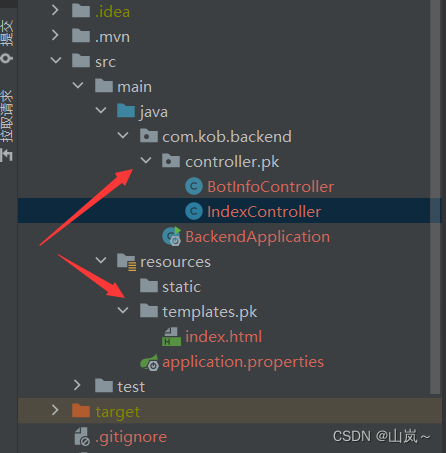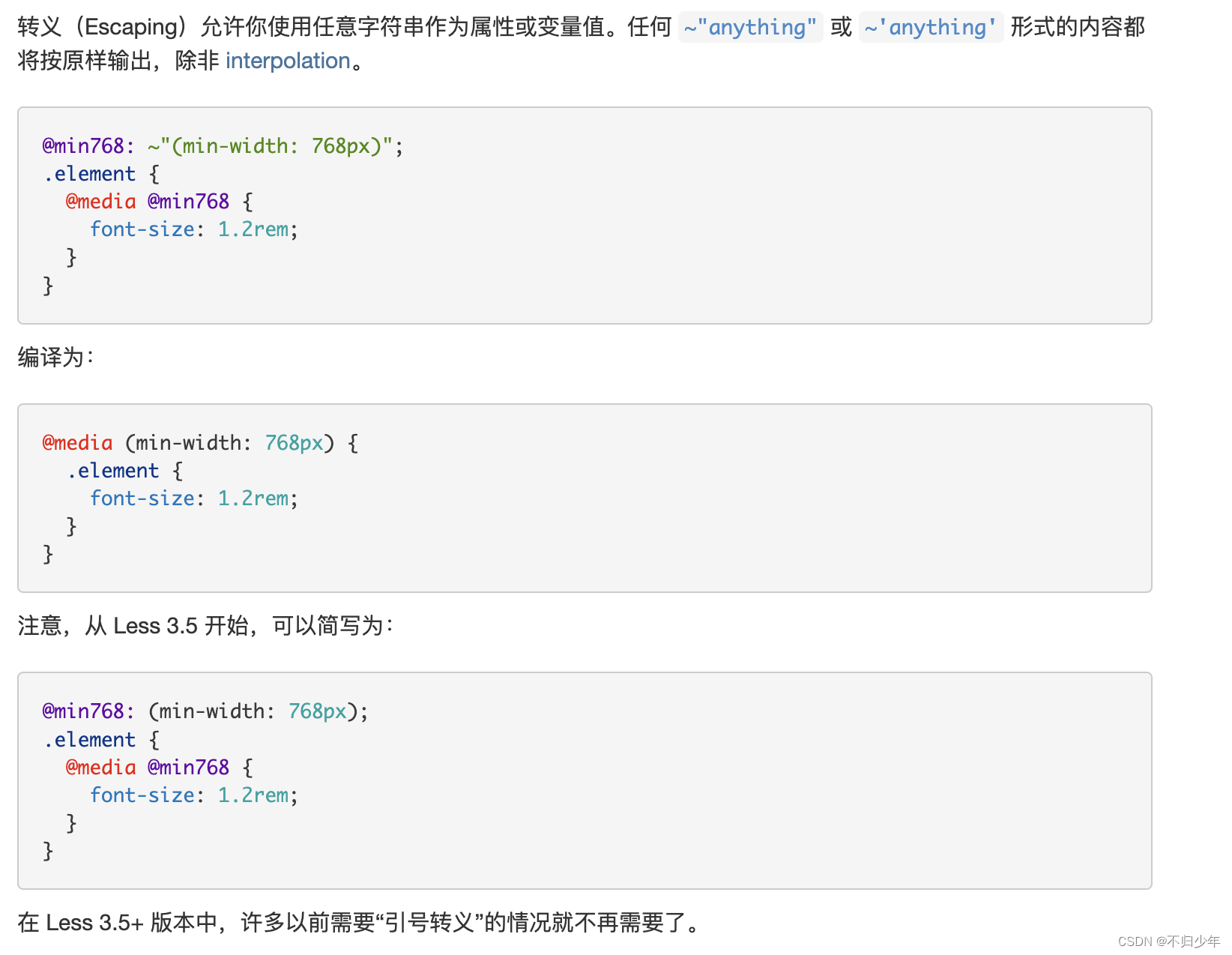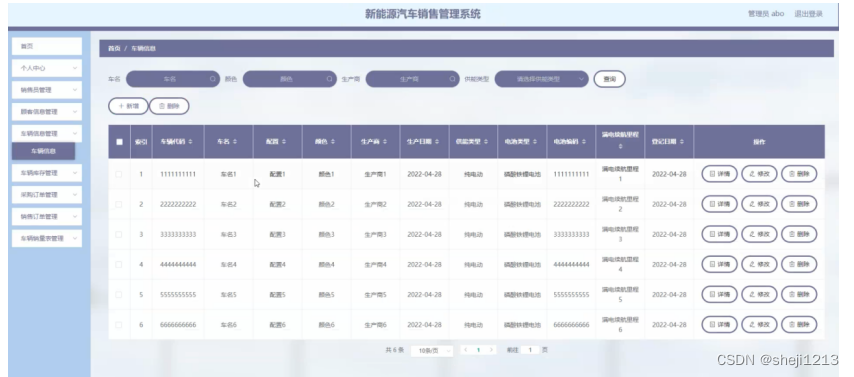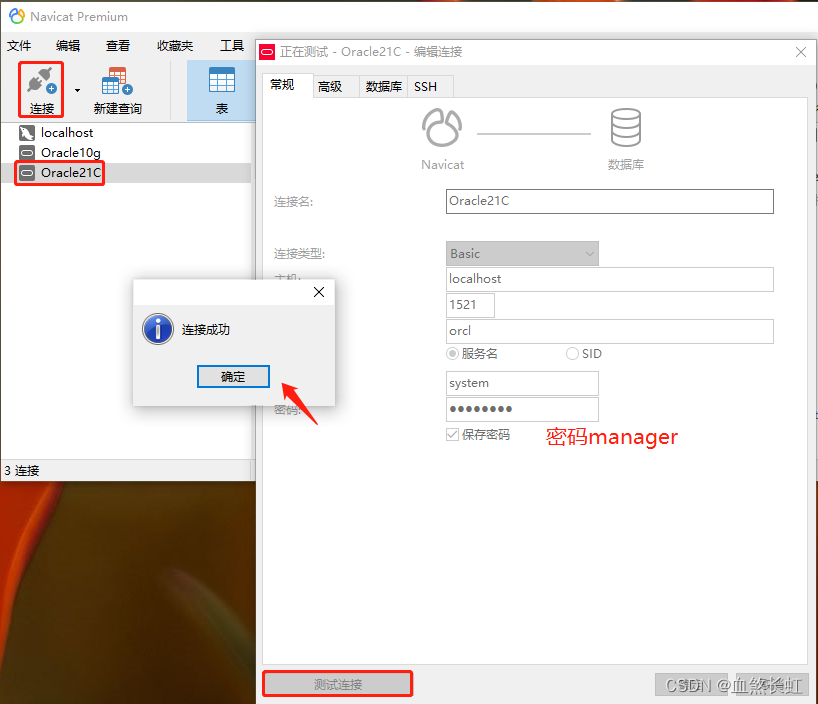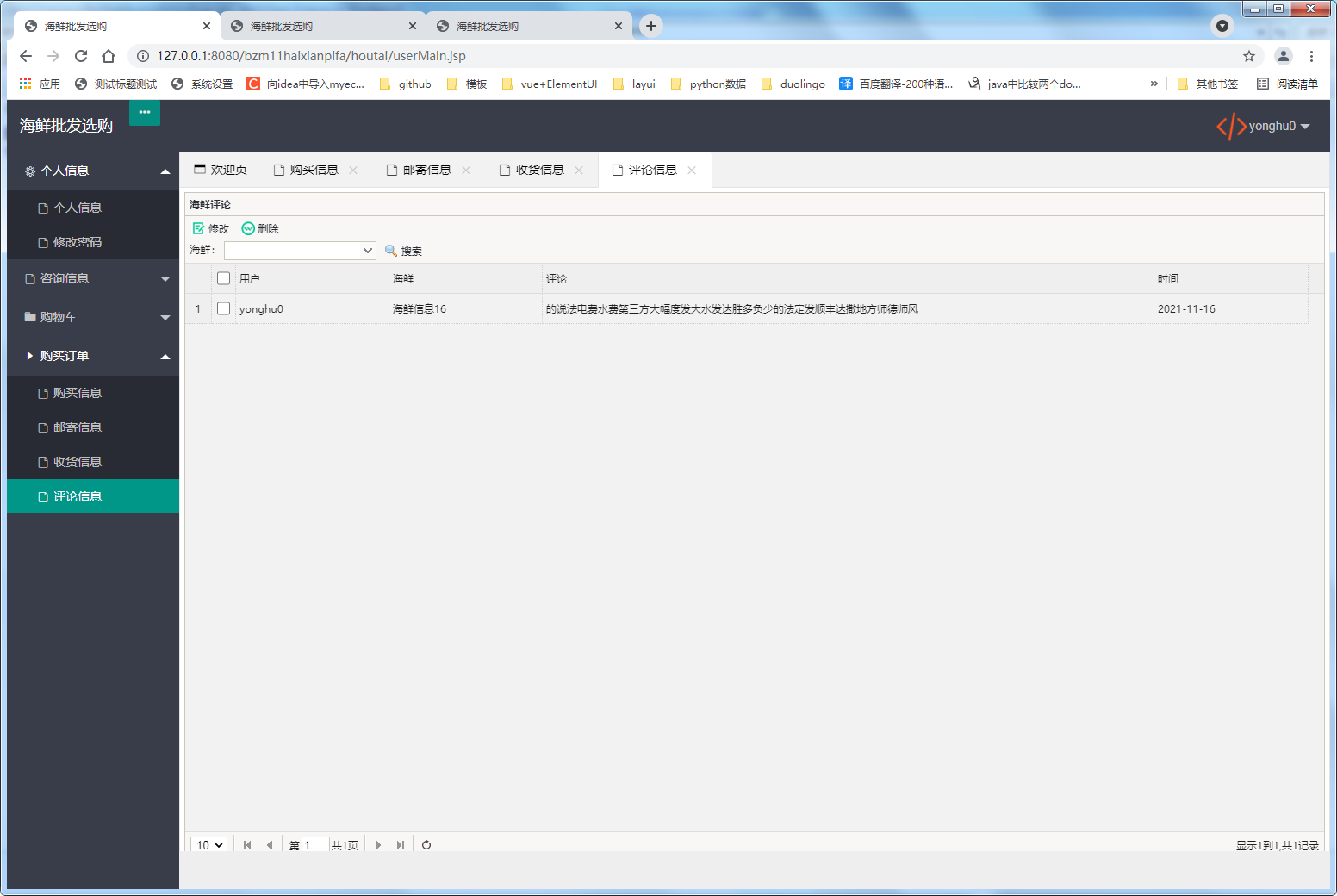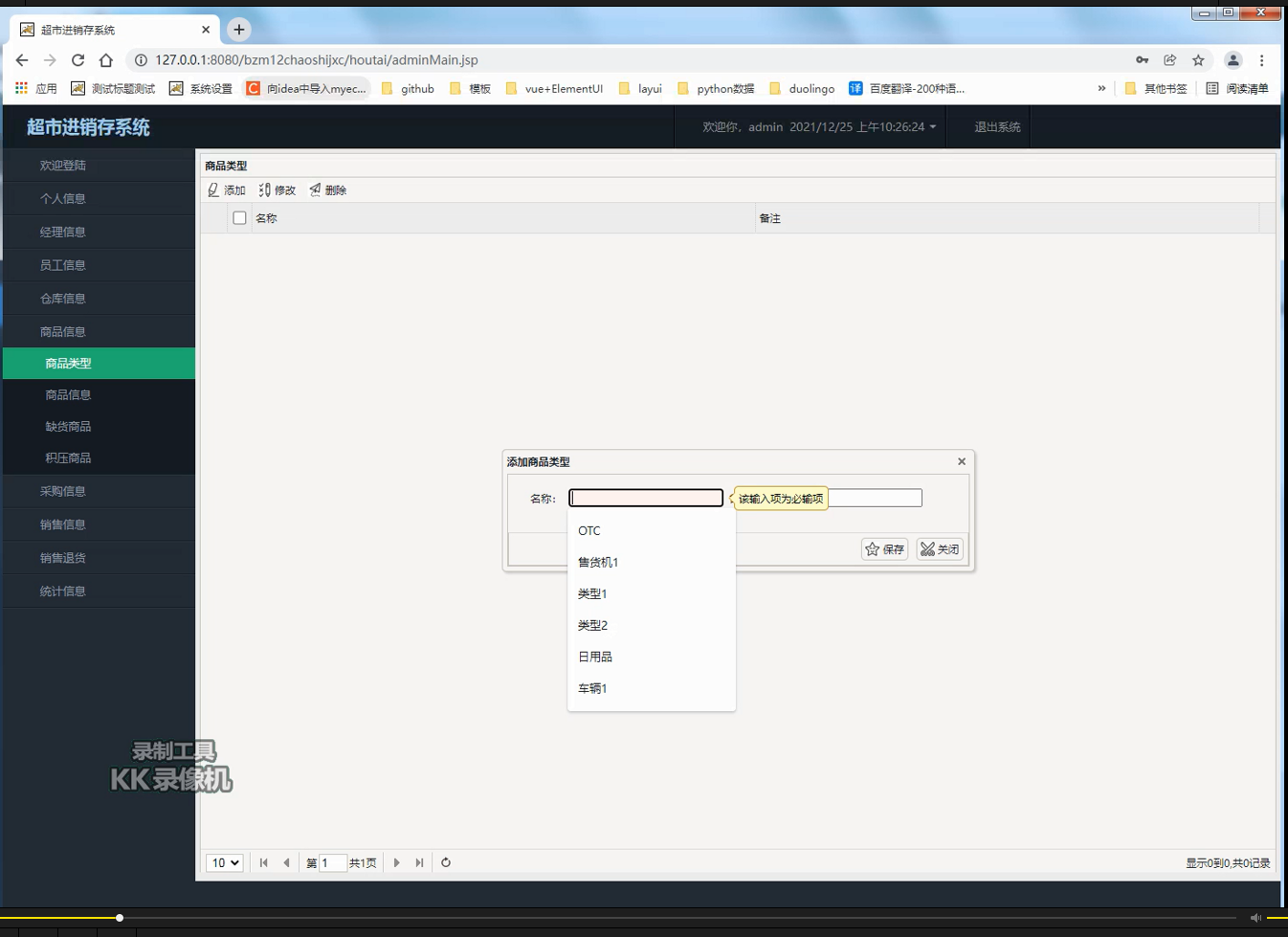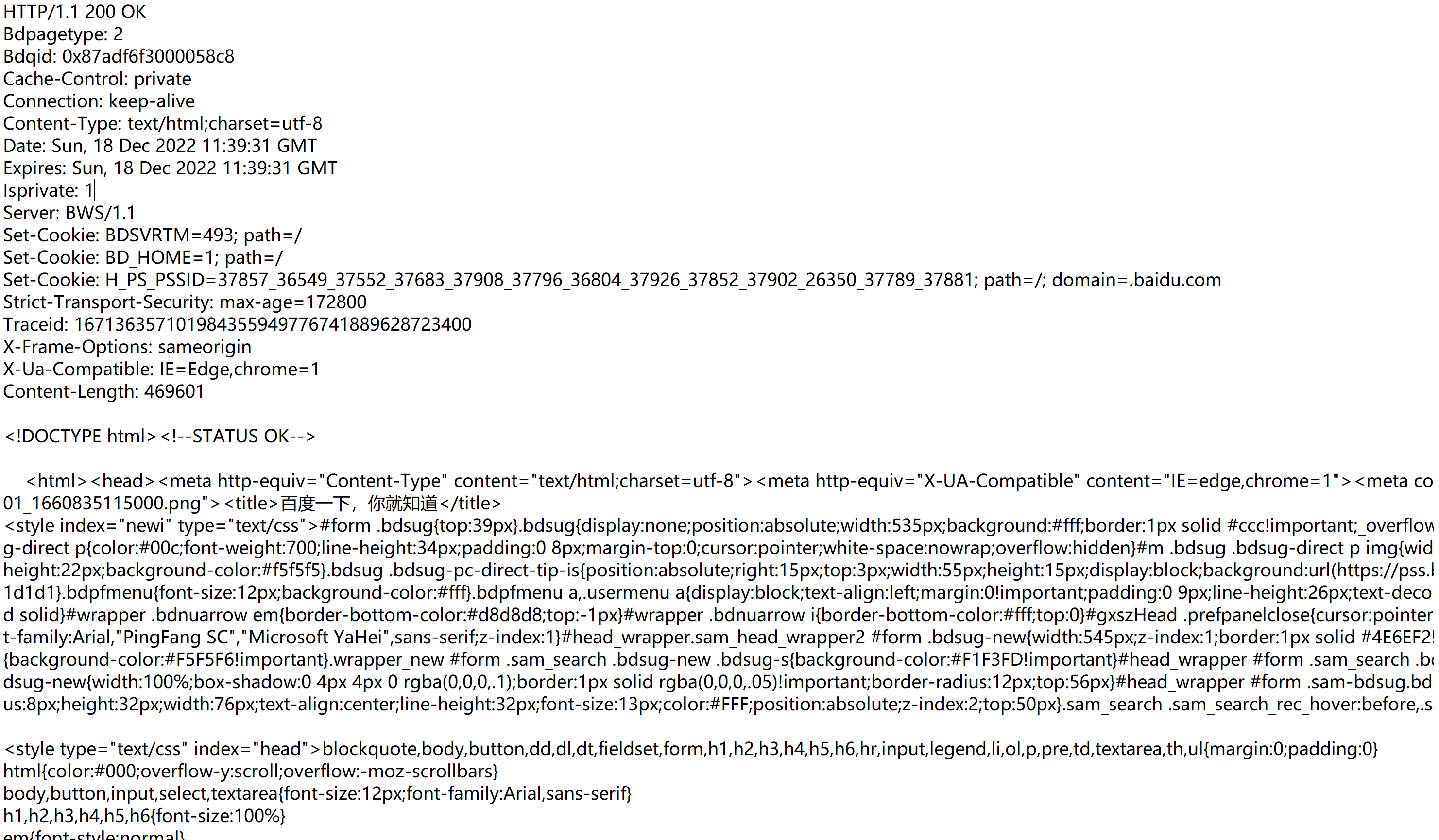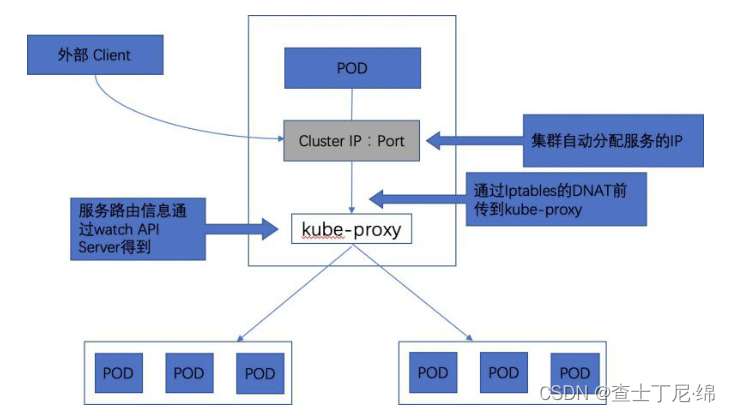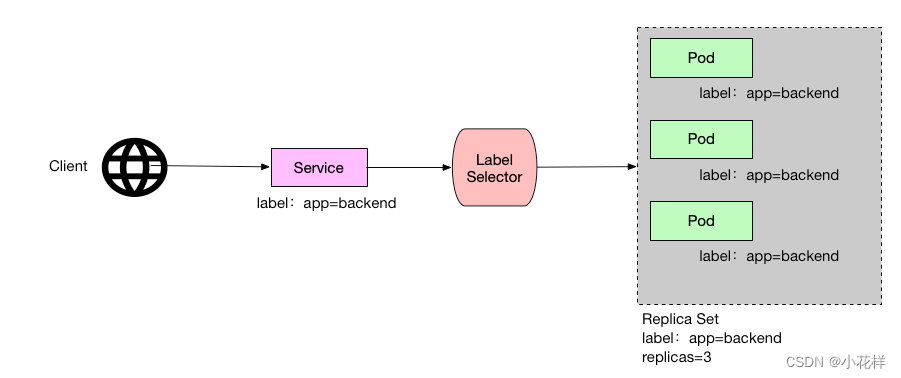一、异常的背景
1.1、初识异常
其实在我们开发中,就是代码出现意外状况。影响到程序的运行。
其实,在我们接触代码开始,就一直在接触异常,只是从来没有分类。
这点在java中,更加明显。
现在我们就来基本了解一下异常。
算数异常 ArithmeticException
public static void main(String[] args) {
int a = 10;
System.out.println(a / 0);
}

数组越界异常 ArrayIndexOutOfBoundsException
public static void main(String[] args) {
int[] array = {1,2,3,4,5};
for (int i = 0; i < 10; i++) {
System.out.println(array[i]);
}
}
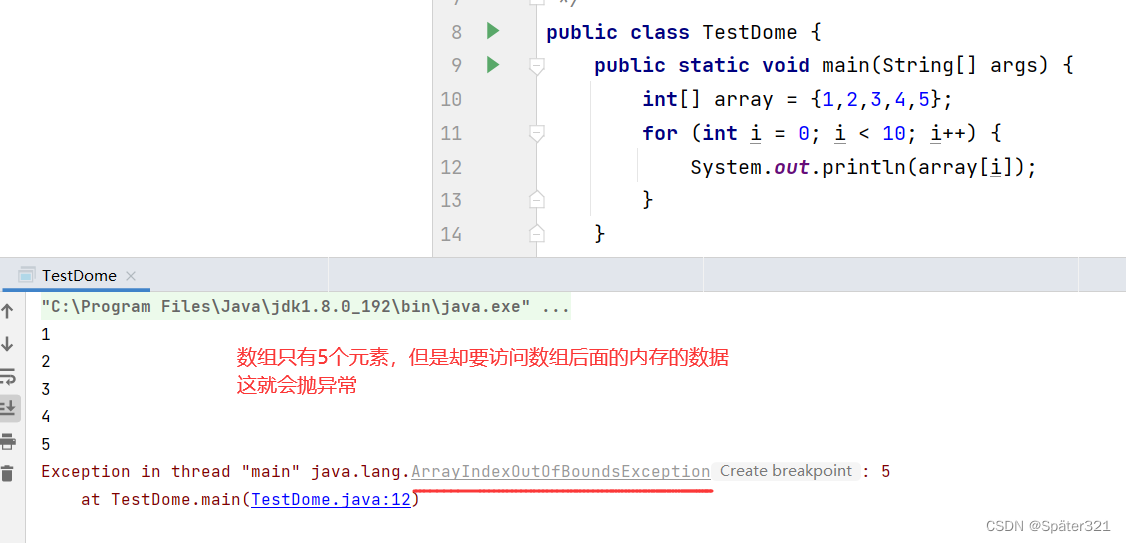
空指针异常 NullPointerException
public static void main(String[] args) {
String str = null;
System.out.println(str.length());
}

所谓异常指的就是程序在 运行时 出现错误时通知调用者的一种机制
关键字 “运行时”
有些错误是这样的, 例如将 System.out.println 拼写错了, 写成了 system.out.println. 此时编译过程中就会出错, 这是 “编译期” 出错.
而运行时指的是程序已经编译通过得到 class 文件了, 再由 JVM 执行过程中出现的错误
异常的种类有很多, 不同种类的异常具有不同的含义, 也有不同的处理方式
1.2、防御式编程
错误在代码中是客观存在的. 因此我们要让程序出现问题的时候及时通知程序猿. 我们有两种主要的方式
- LBYL: Look Before You Leap. 在操作之前就做充分的检查.
- EAFP: It’s Easier to Ask Forgiveness than Permission. “事后获取原谅比事前获取许可更容易”. 也就是先操作, 遇到
问题再处理
异常的核心思想就是 EAFP
1.3、异常的好处
下面,我们用伪代码演示一下开始一局王者荣耀的过程
LBYL 风格的代码(不使用异常)
boolean ret = false;
ret = 登陆游戏();
if (!ret) {
处理登陆游戏错误;
return;
}
ret = 开始匹配();
if (!ret) {
处理匹配错误;
return;
}
ret = 游戏确认();
if (!ret) {
处理游戏确认错误;
return;
}
ret = 选择英雄();
if (!ret) {
处理选择英雄错误;
return;
}
ret = 载入游戏画面();
if (!ret) {
处理载入游戏错误;
return;
}
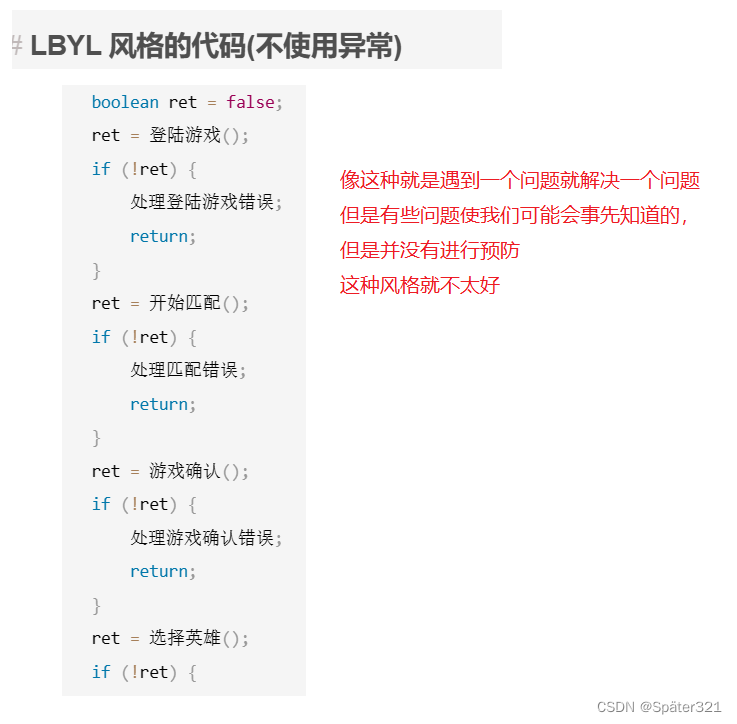
EAFP 风格的代码(使用异常)
try {
登陆游戏();
开始匹配();
游戏确认();
选择英雄();
载入游戏画面();
...
} catch (登陆游戏异常) {
处理登陆游戏异常;
} catch (开始匹配异常) {
处理开始匹配异常;
} catch (游戏确认异常) {
处理游戏确认异常;
} catch (选择英雄异常) {
处理选择英雄异常;
} catch (载入游戏画面异常) {
处理载入游戏画面异常;
}
......
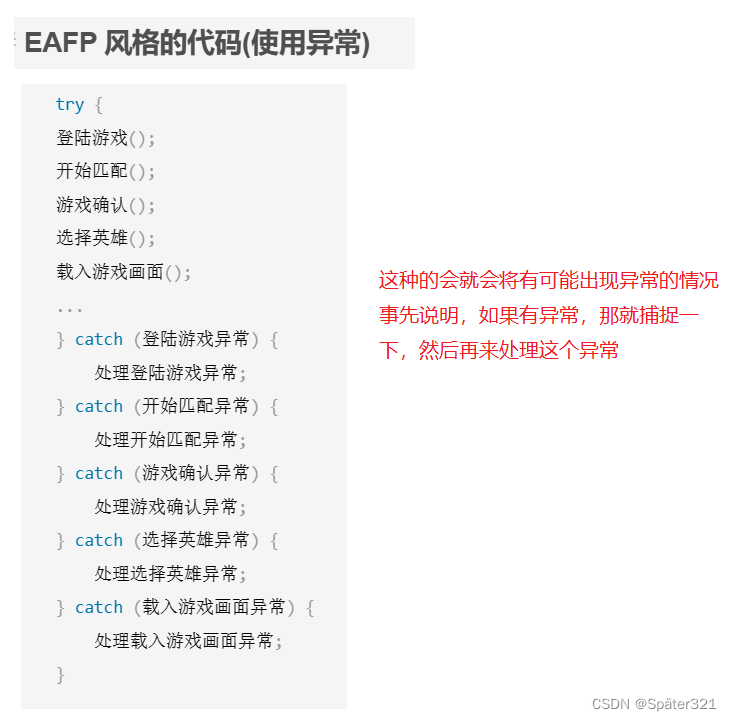
对比两种不同风格的代码, 我们可以发现, 使用第一种方式, 正常流程和错误处理流程代码混在一起, 代码整体显的比较
混乱. 而第二种方式正常流程和错误流程是分离开的, 更容易理解代码
二、异常的基本用法
2.1、基本语法
try{
有可能出现异常的语句 ;
}[catch (异常类型 异常对象) {
} ... ]
[finally {
异常的出口
}]
- try 代码块中放的是可能出现异常的代码.
- catch 代码块中放的是出现异常后的处理行为.
- finally 代码块中的代码用于处理善后工作, 会在最后执行.
- 其中 catch 和 finally 都可以根据情况选择加或者不加
2.2、使用try-catch处理异常
代码示例1 不处理异常
public static void main(String[] args) {
int[] array = {1,2,3,4,5};
System.out.println(array[10]);
}
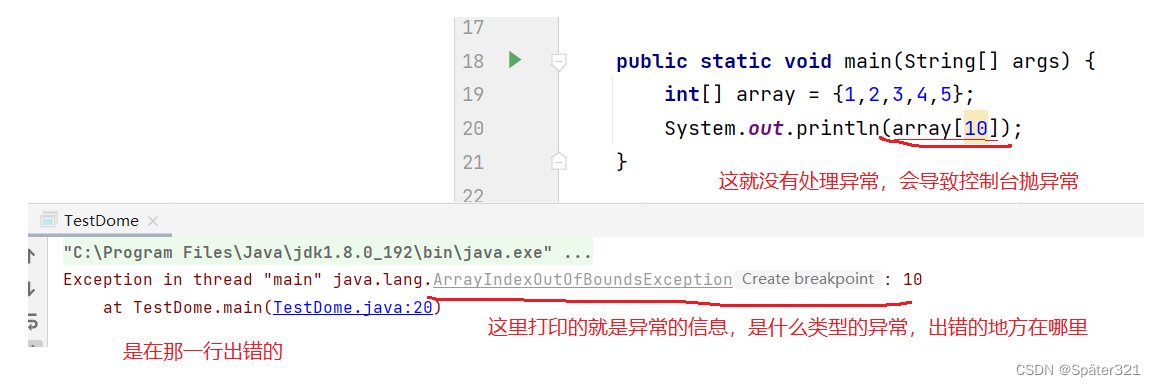
代码示例2 处理异常
public static void main(String[] args) {
int[] array = {1,2,3,4,5};
try{
System.out.println(array[10]);
System.out.println("asddfddf");
}catch(ArrayIndexOutOfBoundsException e){
e.printStackTrace();
System.out.println("捕捉到了数组越界异常");
System.out.println("哈哈");
}
System.out.println("代码执行到了这里");
}
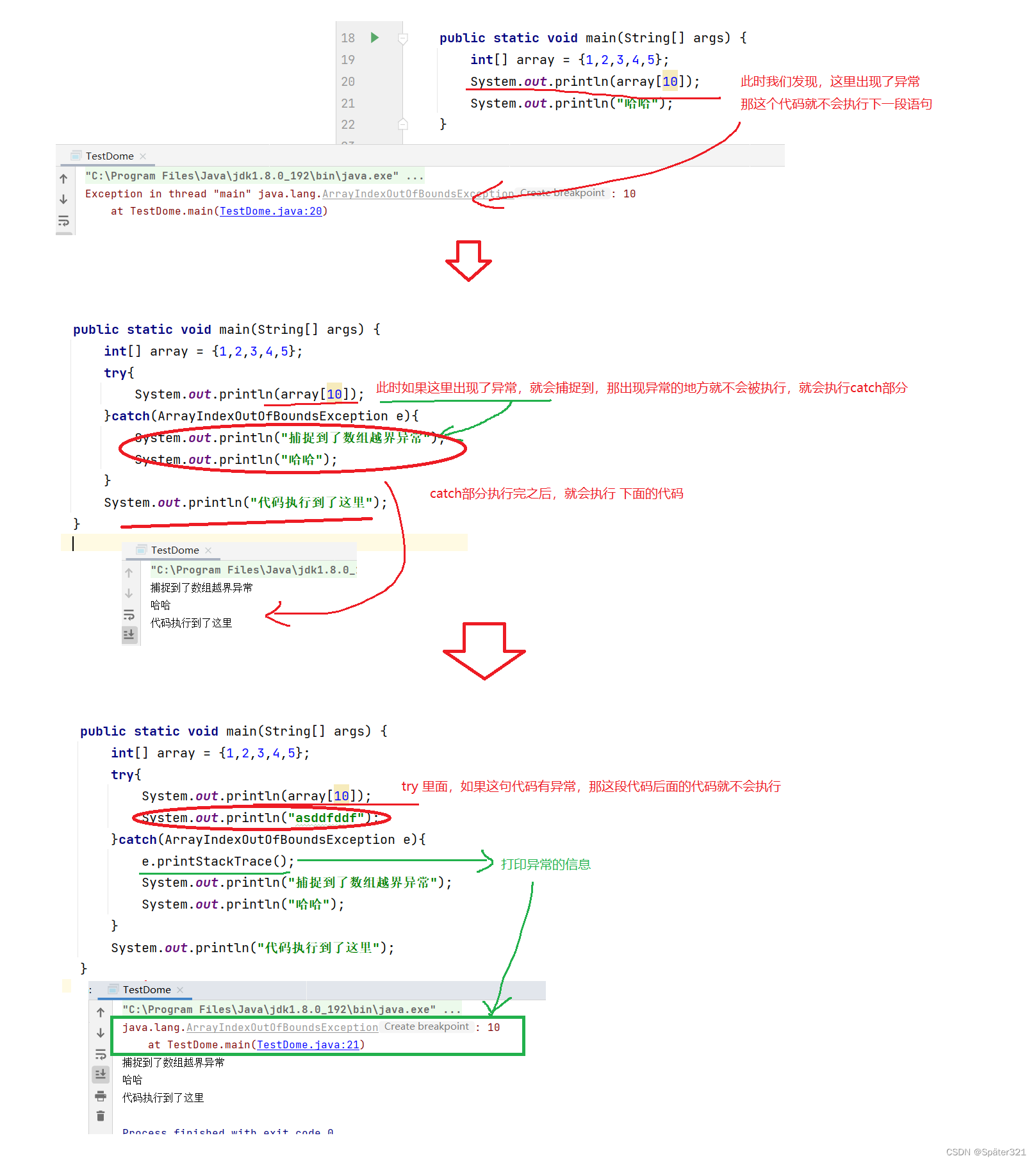
我们发现,一旦 try 中出现异常,那么 try 代码块中的程序就不会继续执行,而是交给 catch 中的代码来执行,catch 执行完毕会继续往下执行
关于异常的处理方式
- 异常的种类有很多, 我们要根据不同的业务场景来决定.
- 对于比较严重的问题(例如和算钱相关的场景), 应该让程序直接崩溃, 防止造成更严重的后果
- 对于不太严重的问题(大多数场景), 可以记录错误日志, 并通过监控报警程序及时通知程序猿
- 对于可能会恢复的问题(和网络相关的场景), 可以尝试进行重试.
- 在我们当前的代码中采取的是经过简化的第二种方式. 我们记录的错误日志是出现异常的方法调用信息, 能很快 速的让我们找到出现异常的位置. 以后在实际工作中我们会采取更完备的方式来记录异常信息
关于 “调用栈”
- 方法之间是存在相互调用关系的, 这种调用关系我们可以用 “调用栈” 来描述,在 JVM 中有一块内存空间称为 “虚拟机栈” 专门存储方法之间的调用关系,当代码中出现异常的时候,我们就可以使用 e.printStackTrace(); 的方式查看出现异常代码的调用栈
如果我们不处理异常,那这个异常就会交给JVM来处理,那这个程序就会终止
如果而我们处理了异常,那这个程序机会往下执行
public static void main(String[] args) {
int[] array = {1,2,3,4,5};
try{
System.out.println(array[10]);
System.out.println("asddfddf");
}catch(ArrayIndexOutOfBoundsException e){
e.printStackTrace();
System.out.println("捕捉到了数组越界异常,然后处理异常");
for (int i = 0; i < array.length; i++) {
System.out.print(array[i] + " ");
}
}
}

代码示例3 catch 只能处理对应种类的异常
public static void main(String[] args) {
int[] array = {1,2,3,4,5};
try{
int a = 10 / 0;
System.out.println(array[10]);
System.out.println("hello");
}catch(ArrayIndexOutOfBoundsException e){
e.printStackTrace();
System.out.println("捕捉到了数组越界异常,然后处理异常");
for (int i = 0; i < array.length; i++) {
System.out.print(array[i] + " ");
}
}
}
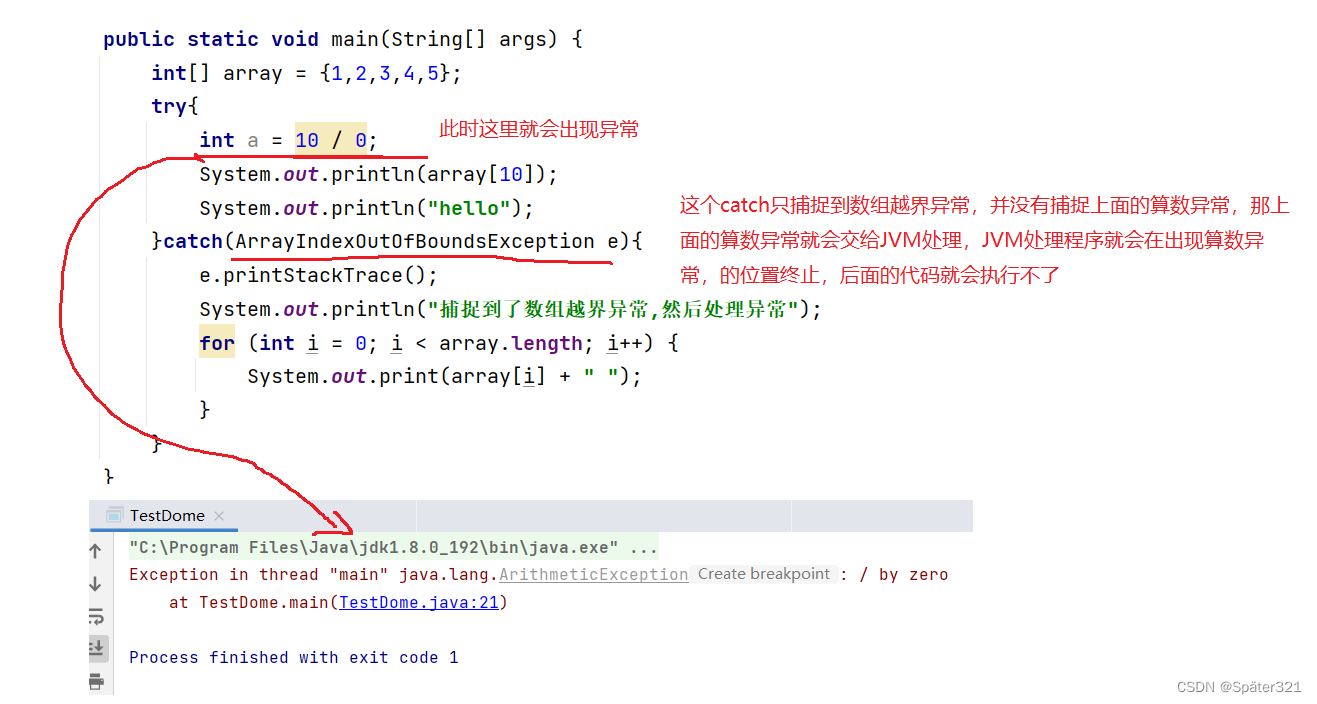
代码示例4 catch 可以有多个
public static void main(String[] args) {
int[] array = {1,2,3,4,5};
try{
int a = 10 / 0;
System.out.println(array[10]);
System.out.println("hello");
}catch(ArrayIndexOutOfBoundsException e){
e.printStackTrace();
System.out.println("捕捉到了数组越界异常,然后处理异常");
for (int i = 0; i < array.length; i++) {
System.out.print(array[i] + " ");
}
} catch(ArithmeticException e){
e.printStackTrace();
System.out.println("捕捉到了算数异常,处理异常");
int a = 10 / 2;
System.out.println(a);
}
System.out.println("哈哈");
}
简写上面的代码,捕捉个异常中间可以用“|”连接
public static void main(String[] args) {
int[] array = {1,2,3,4,5};
try{
int a = 10 / 0;
System.out.println(array[10]);
System.out.println("hello");
}catch(ArrayIndexOutOfBoundsException | ArithmeticException e){
e.printStackTrace();
System.out.println("捕捉到了数组越界异常或者捕捉到了算数异常,然后处理异常");
int a = 10;
System.out.println(a / 2);
for (int i = 0; i < array.length; i++) {
System.out.print(array[i] + " ");
}
}
System.out.println("哈哈");
}
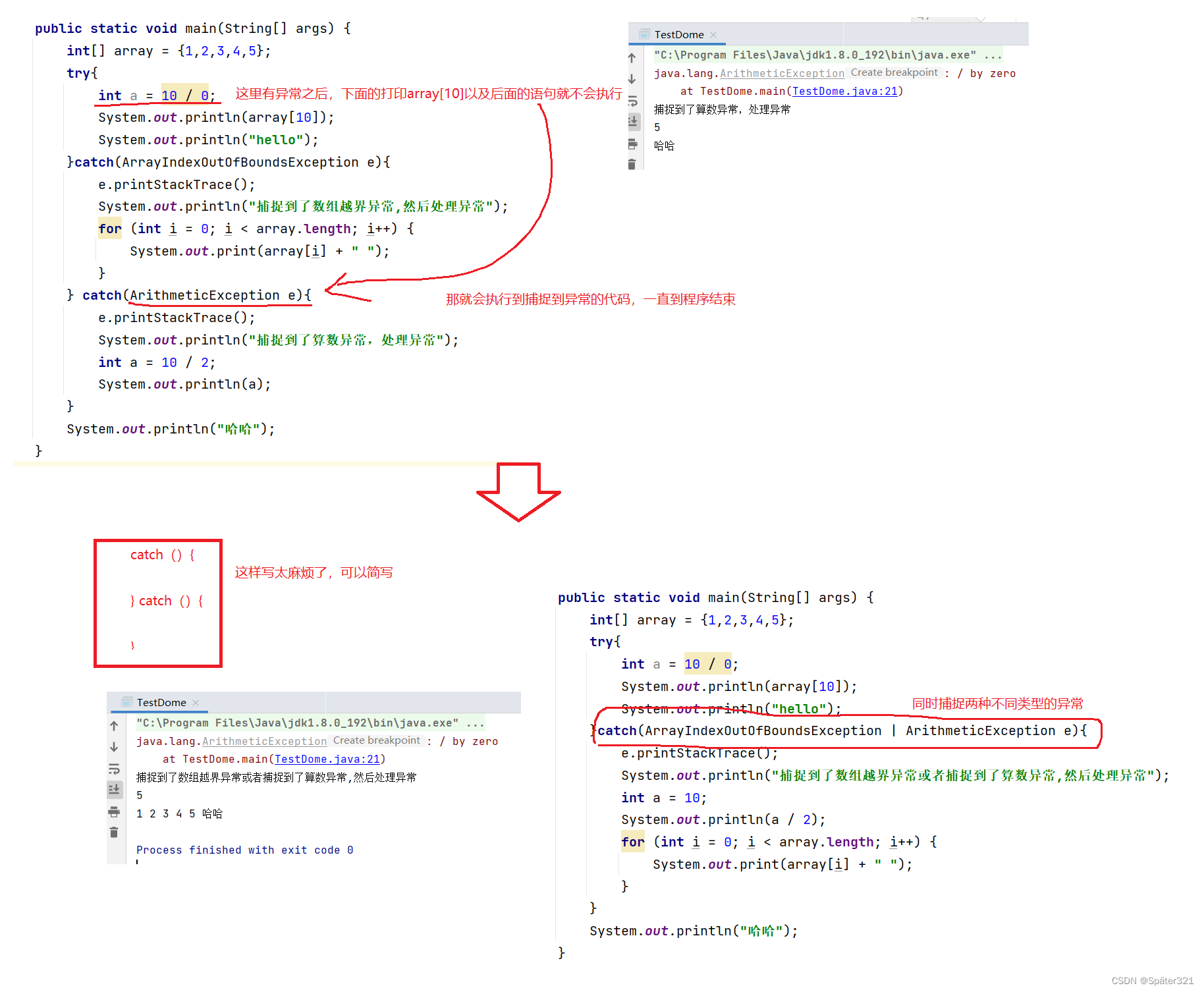
2.3、异常的体系结构
Java 内置了丰富的异常体系, 用来表示不同情况下的异常.
下图表示 Java 内置的异常类之间的继承关系:
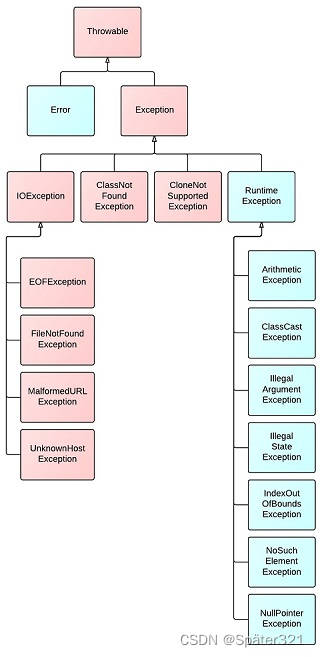
- 顶层类 Throwable 派生出两个重要的子类, Error 和 Exception
- 其中 Error 指的是 Java 运行时内部错误和资源耗尽错误. 应用程序不抛出此类异常. 这种内部错误一旦出现,除了告知用户并使程序终止之外, 再无能无力. 这种情况很少出现.
- Exception 是我们程序猿所使用的异常类的父类.
- 其中 Exception 有一个子类称为 RuntimeException , 这里面又派生出很多我们常见的异常类NullPointerException , IndexOutOfBoundsException 等.
Java语言规范将派生于 Error 类或 RuntimeException 类的所有异常称为 非受查异常, 所有的其他异常称为 受查
异常
2.2.1、异常的分类
异常的分类:
- 1、受查异常(编译时异常),
- 2、非受查异常(运行时异常)
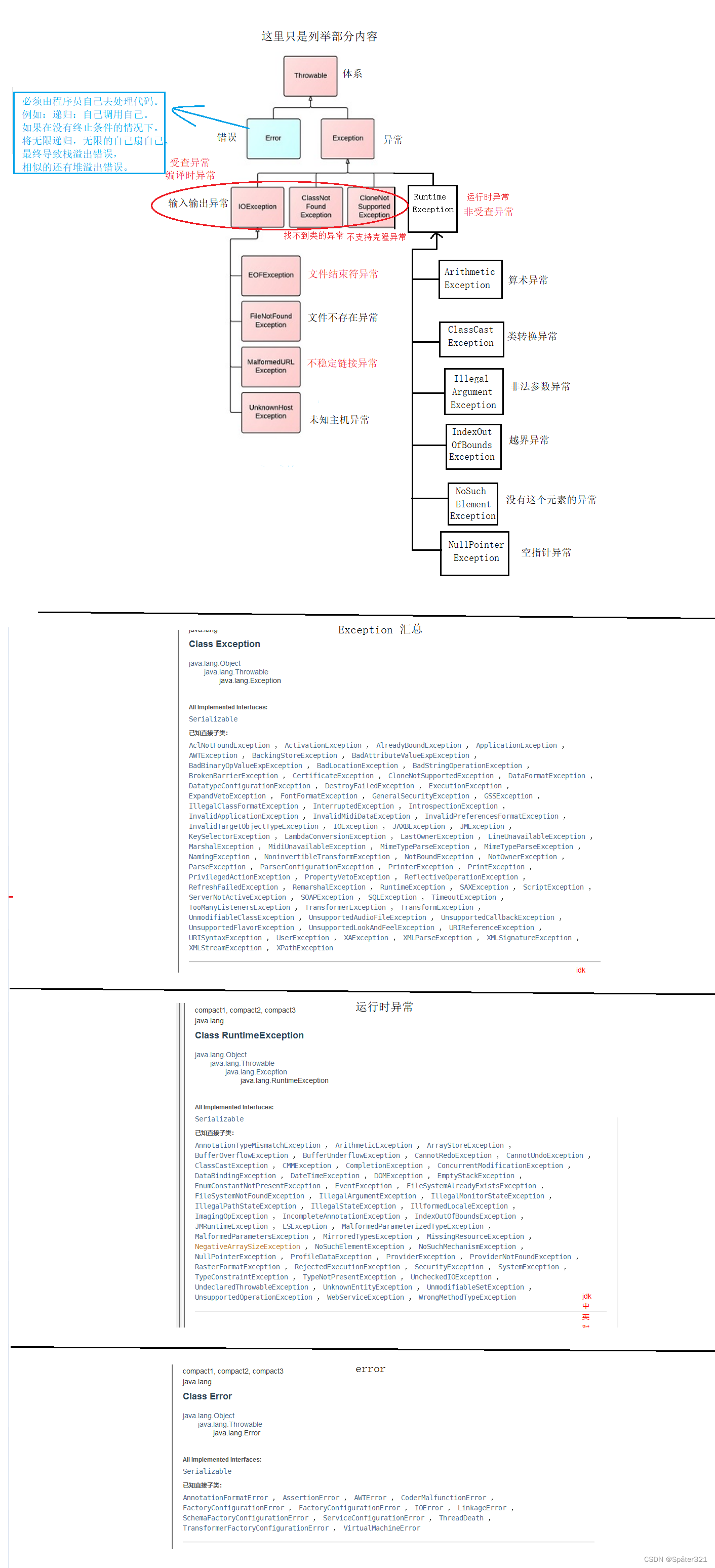
2.4 finally的使用
代码示例5 也可以用一个 catch 捕获所有异常(不推荐)
public static void main(String[] args) {
int[] array = {1,2,3,4,5};
try{
int a = 10 / 0;
System.out.println(array[10]);
System.out.println("hello");
}catch(Exception e){
e.printStackTrace();
System.out.println("捕捉到了数组越界异常或者捕捉到了算数异常,然后处理异常");
int a = 10;
System.out.println(a / 2);
for (int i = 0; i < array.length; i++) {
System.out.print(array[i] + " ");
}
}
System.out.println("哈哈");
}
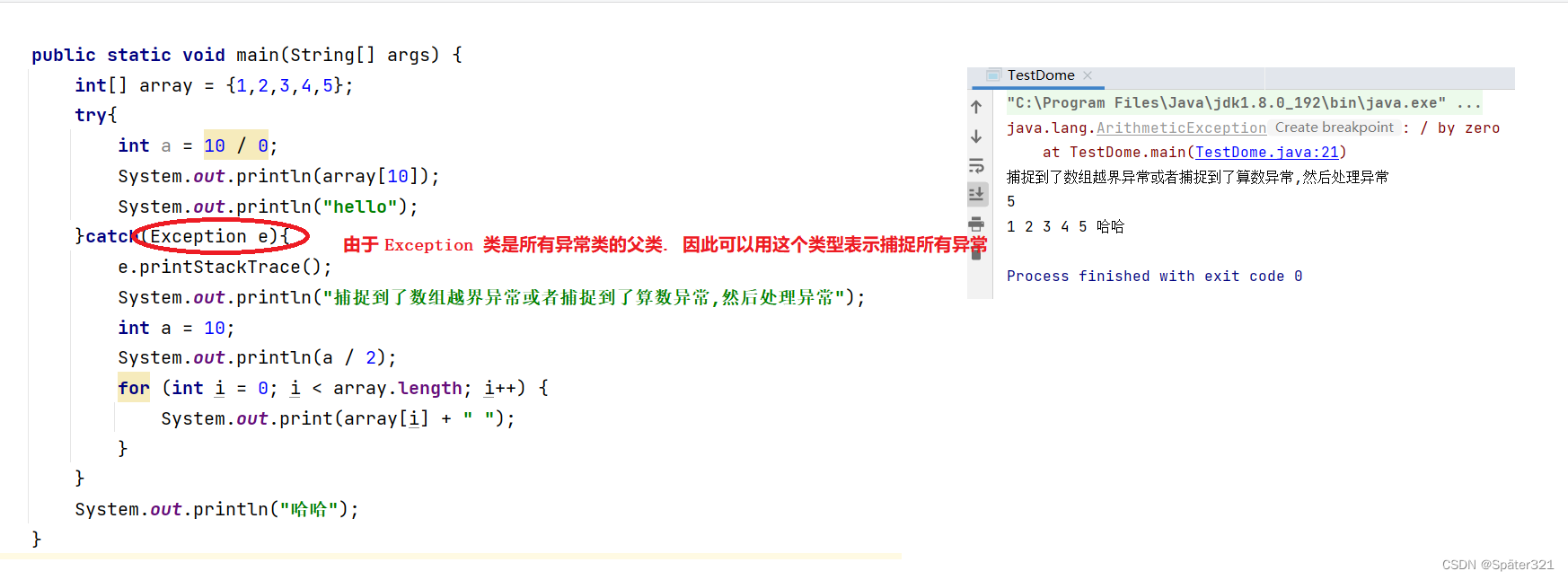
由于 Exception 类是所有异常类的父类. 因此可以用这个类型表示捕捉所有异常.
- 备注:catch 进行类型匹配的时候,不光会匹配相同类型的异常对象,也会捕捉目标异常类型的子类对象。
- 如刚才的代码,ArithmeticException 和 ArrayIndexOutOfBoundsException 都是 Exception 的子类,因此都能被捕获到
catch在捕获异常的时候最好是捕获具体的异常类型(捕获的时候最好是先捕获子类的异常,然后在捕获父类的异常,不然就会报错)
现在我们知道 ArithmeticException 和 ArrayIndexOutOfBoundsException 都是 Exception 的子类
如果我们先捕获父类的异常,此时就会报错
public static void main(String[] args) {
int[] array = {1,2,3,4,5};
try{
int a = 10 / 0;
System.out.println(array[10]);
System.out.println("hello");
}catch(Exception e){
e.printStackTrace();
System.out.println("捕捉到了数组越界异常或者捕捉到了算数异常,然后处理异常");
}catch(ArrayIndexOutOfBoundsException | ArithmeticException e) {
e.printStackTrace();
System.out.println("捕捉到了数组越界异常或者捕捉到了算数异常,然后处理异常");
}
System.out.println("哈哈");
}
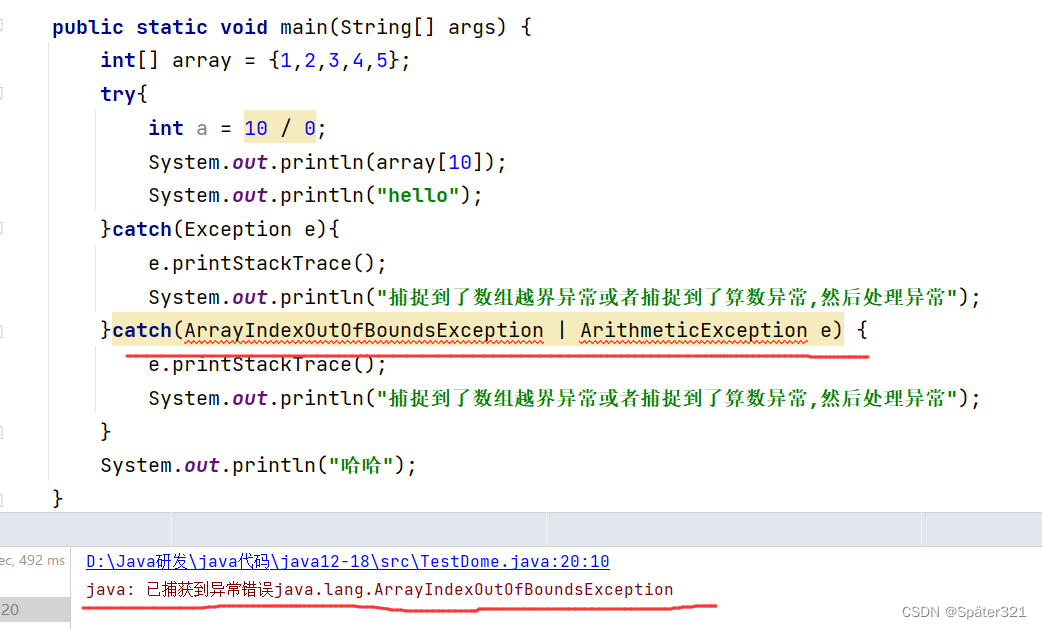
所以我们要先捕获子类的异常
public static void main(String[] args) {
int[] array = {1,2,3,4,5};
try{
int a = 10 / 0;
System.out.println(array[10]);
System.out.println("hello");
}catch(ArrayIndexOutOfBoundsException | ArithmeticException e) {
e.printStackTrace();
System.out.println("捕捉到了数组越界异常或者捕捉到了算数异常,然后处理异常");
} catch(Exception e){
e.printStackTrace();
System.out.println("捕捉父类的异常");
}
System.out.println("哈哈");
}
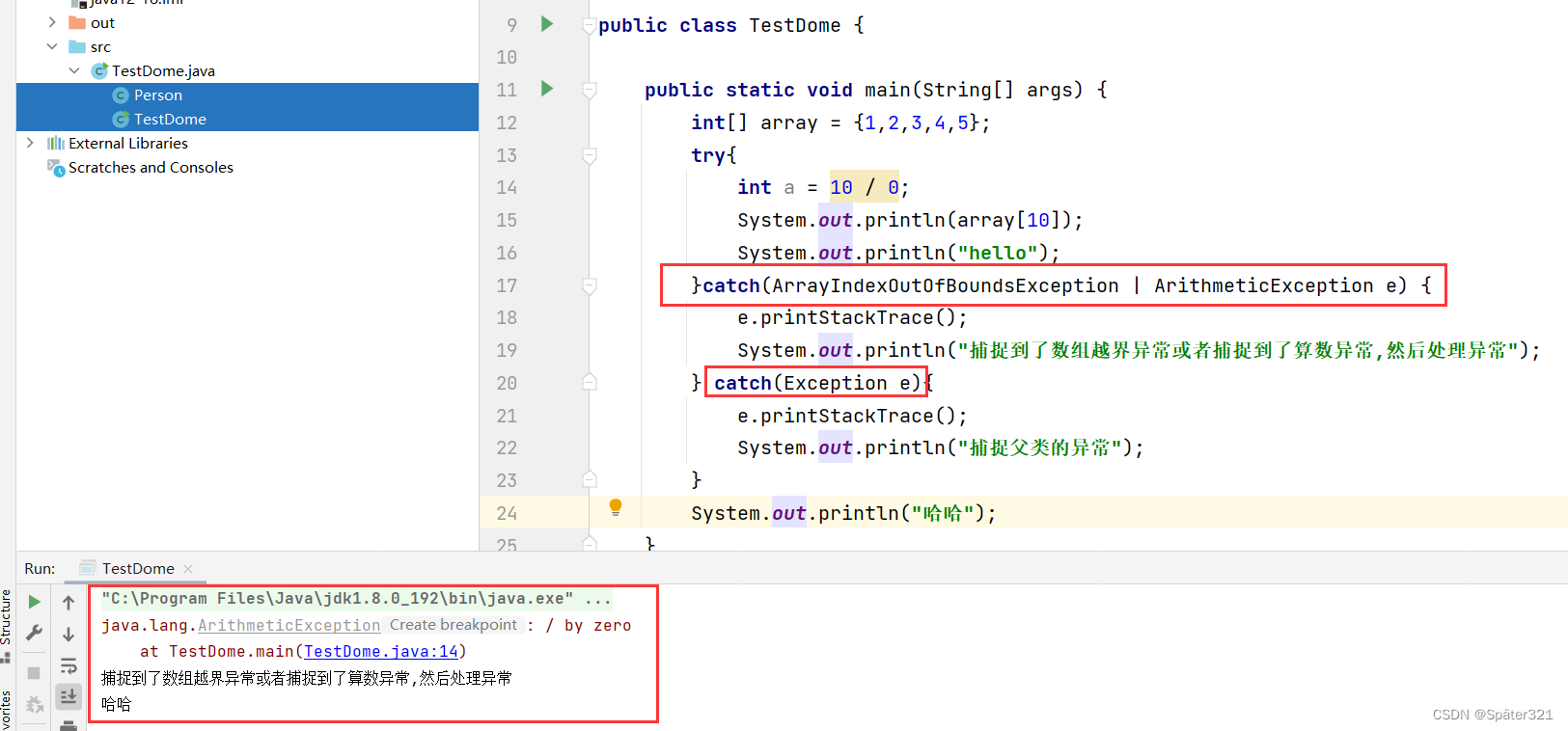
代码示例6 finally 表示最后的善后工作, 例如释放资源
比如我么要在控制台上面输入数据,Scanner也是一种资源,打开了之后,就要进行关闭
public static void main(String[] args) {
Scanner scanner = new Scanner(System.in);
try{
int a = scanner.nextInt();
int b = 10 / a;
System.out.println("b = " + b);
}catch(ArithmeticException e){
e.printStackTrace();
System.out.println("捕捉到了算数异常");
}
scanner.close();//关闭资源
}

public static void main(String[] args) {
Scanner scanner = new Scanner(System.in);
try{
int a = scanner.nextInt();
int b = 10 / a;
System.out.println("b = " + b);
}catch(ArithmeticException e){
e.printStackTrace();
System.out.println("捕捉到了算数异常");
}finally {
scanner.close();//关闭资源
System.out.println("Scanner关闭了");
}
}
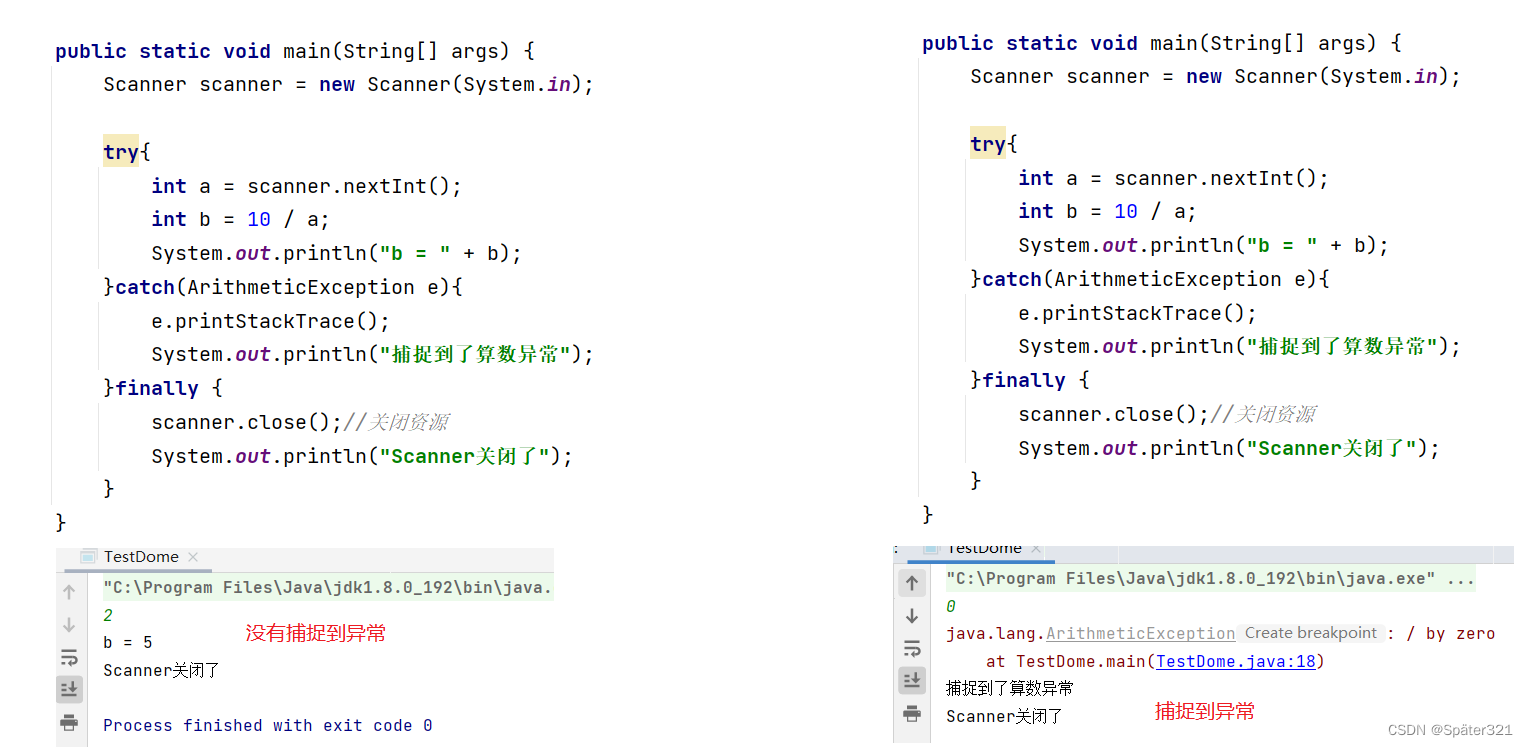
所以finally{ } 包含的代码,无论有没有捕捉到异常都会被 执行
刚才的代码Scanner在new对象的时候,是在try 外面的,现在还有一种等价的写法
public static void main(String[] args) {
try (Scanner scanner = new Scanner(System.in)) {
int a = scanner.nextInt();
int b = 10 / a;
System.out.println("b = " + b);
} catch (ArithmeticException e) {
e.printStackTrace();
System.out.println("捕捉到了算数异常");
} finally {
//关闭资源
System.out.println("Scanner关闭了");
}
}
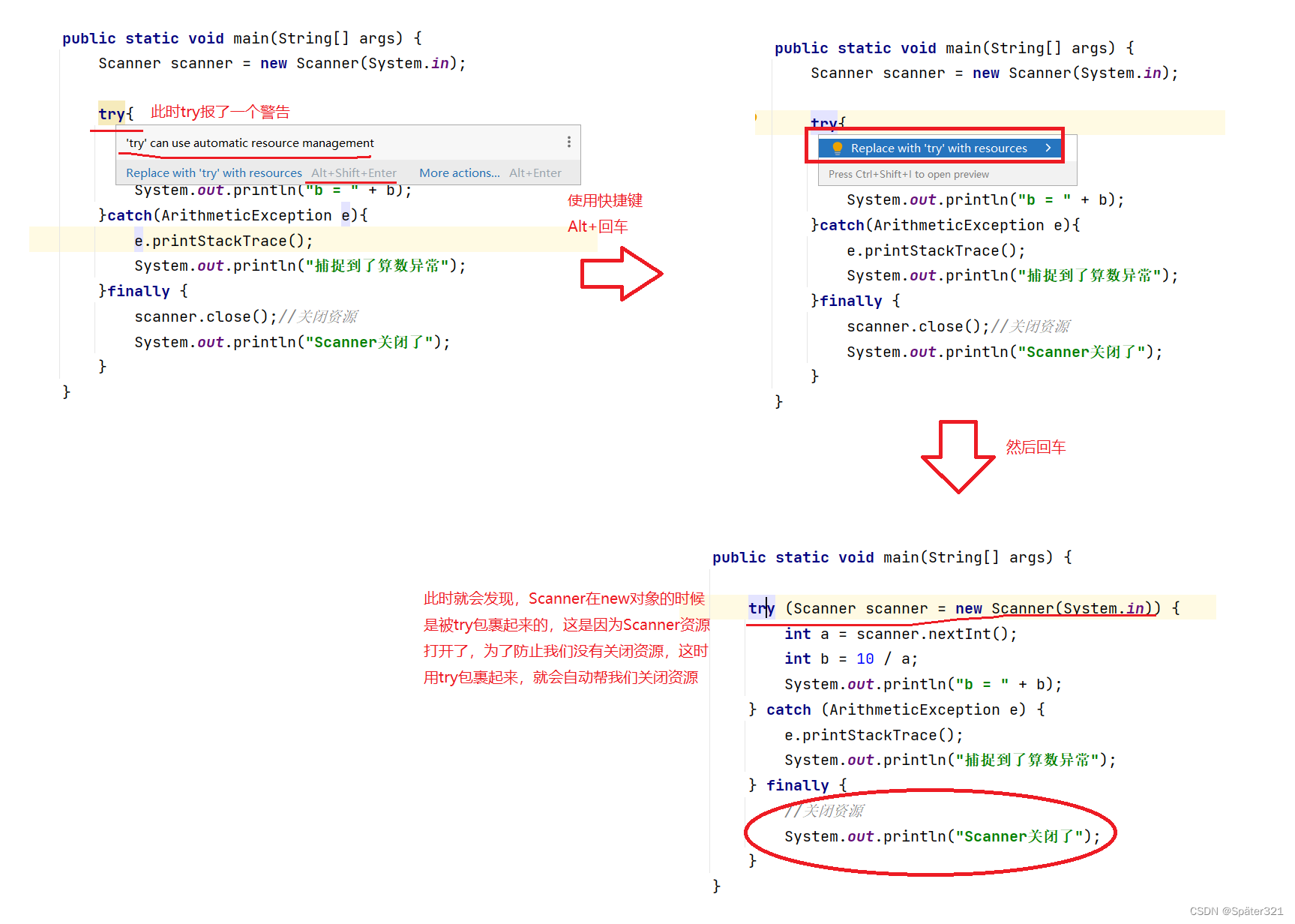
如果我们没有捕捉到异常,异常交给JVM处理,那finally会被执行吗???
public static void main(String[] args) {
try (Scanner scanner = new Scanner(System.in)) {
int a = scanner.nextInt();
int b = 10 / a;
System.out.println("b = " + b);
} catch (NullPointerException e) {
e.printStackTrace();
System.out.println("捕捉到了算数异常");
} finally {
//关闭资源
System.out.println("Scanner关闭了");
}
}

2.4.1、尽量避面在finally中使用return
代码示例
public static int func(){
try{
return 2;
}catch(ArithmeticException e){
e.printStackTrace();
}finally {
return 100;
}
}
public static void main(String[] args) {
System.out.println(func());
}
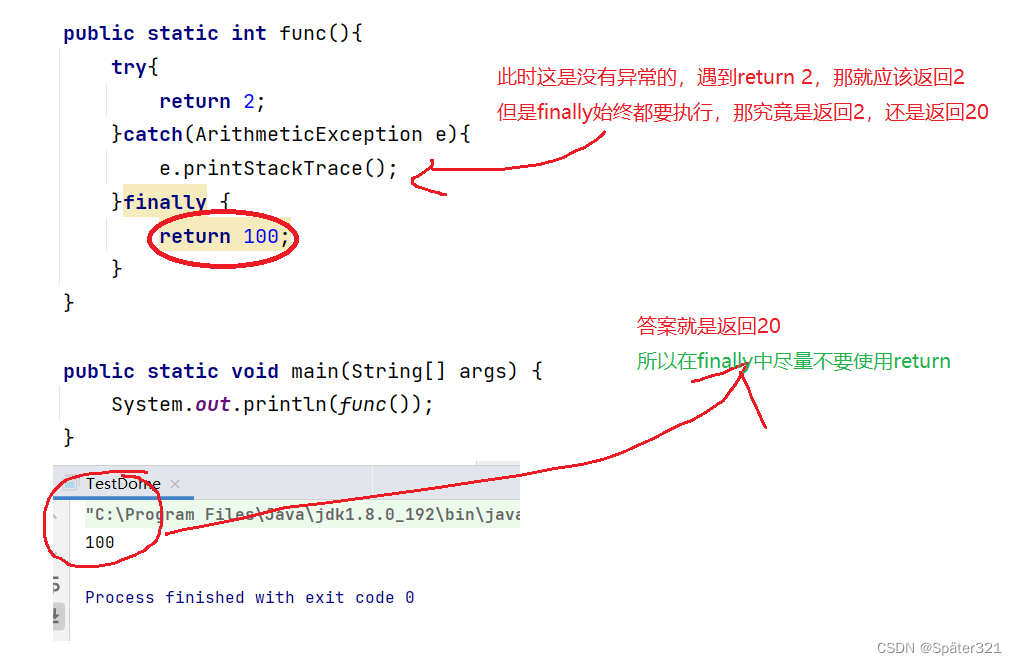
2.5、异常处理流程
- 程序先执行 try 中的代码
- 如果 try 中的代码出现异常,就会结束 try 中的代码,看和 catch 中的异常类型是否匹配.
- 如果找到匹配的异常类型,就会执行 catch 中的代码
- 如果没有找到匹配的异常类型,就会将异常向上传递到上层调用者.
- 无论是否找到匹配的异常类型,finally 中的代码都会被执行到(在该方法结束之前执行).
- 如果上层调用者也没有处理的了异常,就继续向上传递.
- 一直到 main 方法也没有合适的代码处理异常, 就会交给 JVM 来进行处理,此时程序就会异常终止
2.6、抛出异常
除了 Java 内置的类会抛出一些异常之外, 程序猿也可以手动抛出某个异常. 使用 throw 关键字完成这个操作
四、自定义异常
Java 中虽然已经内置了丰富的异常类,但是我们实际场景中可能还有一些情况需要我们对异常类进行扩展,创建符合我们实际情况的异常.
不抛异常的用户登录代码实例
如果我们不抛异常,那这个用户登录代码实现:
public class Test {
public static String name = "baidu";
public static String password = "123456";
public static void login(String name, String password){
if(!Test.name.equals(name)){
System.out.println("用户名错误!");
return;
}
if(!Test.password.equals(password)){
System.out.println("密码错误!");
return;
}
System.out.println("登录成功!");
}
public static void main(String[] args) {
login("baidu","123456");
}
}
如果我们发现用户名或者密码错误。此时就可以抛出自定义异常
但是自定义异常都要继承系统异常,然后在重写构造方法
此时我们在处理用户名密码错误的时候可能就需要抛出两种异常. 我们可以基于已有的异常类进行扩展(继承), 创建和我们业务相关的异常类.
继承受查异常(Exception ),那就要搭配try - catch使用或者使用throws声明
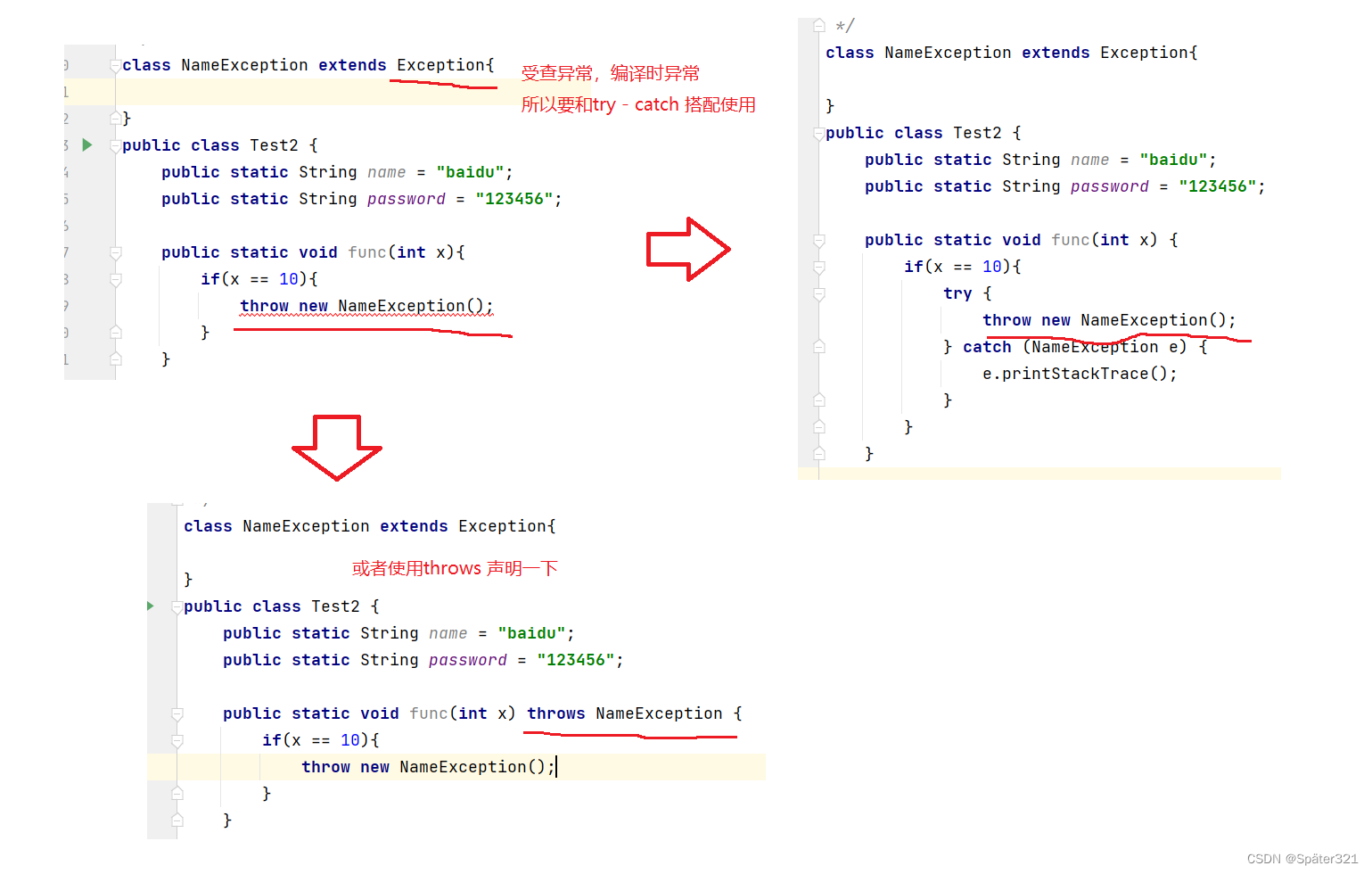
继承非受查异常RuntimeException
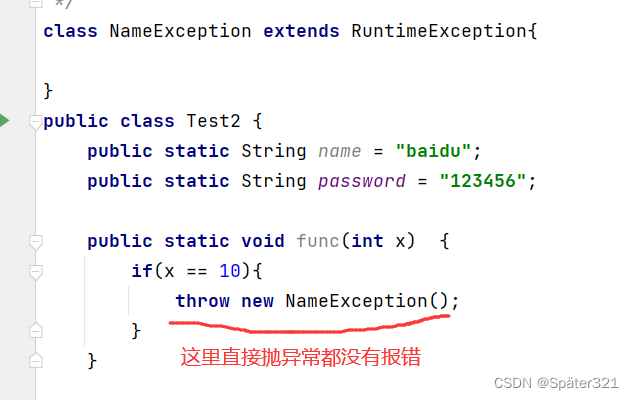
抛异常的用户登录代码实例
class NameException extends RuntimeException{
public NameException(String message) {
super(message);
}
}
class PasswordRuntimeException extends RuntimeException{
public PasswordRuntimeException(String massage){
super(massage);
}
}
public class Test2 {
public static String name = "baidu";
public static String password = "123456";
public static void func(int x) {
}
public static void login(String name, String password){
if(!Test2.name.equals(name)){
throw new NameException("用户名错误!");
}
if(!Test2.password.equals(password)){
throw new PasswordRuntimeException("密码错误!");
}
System.out.println("登录成功!");
}
public static void main(String[] args) {
login("baidu","123456");
}
}
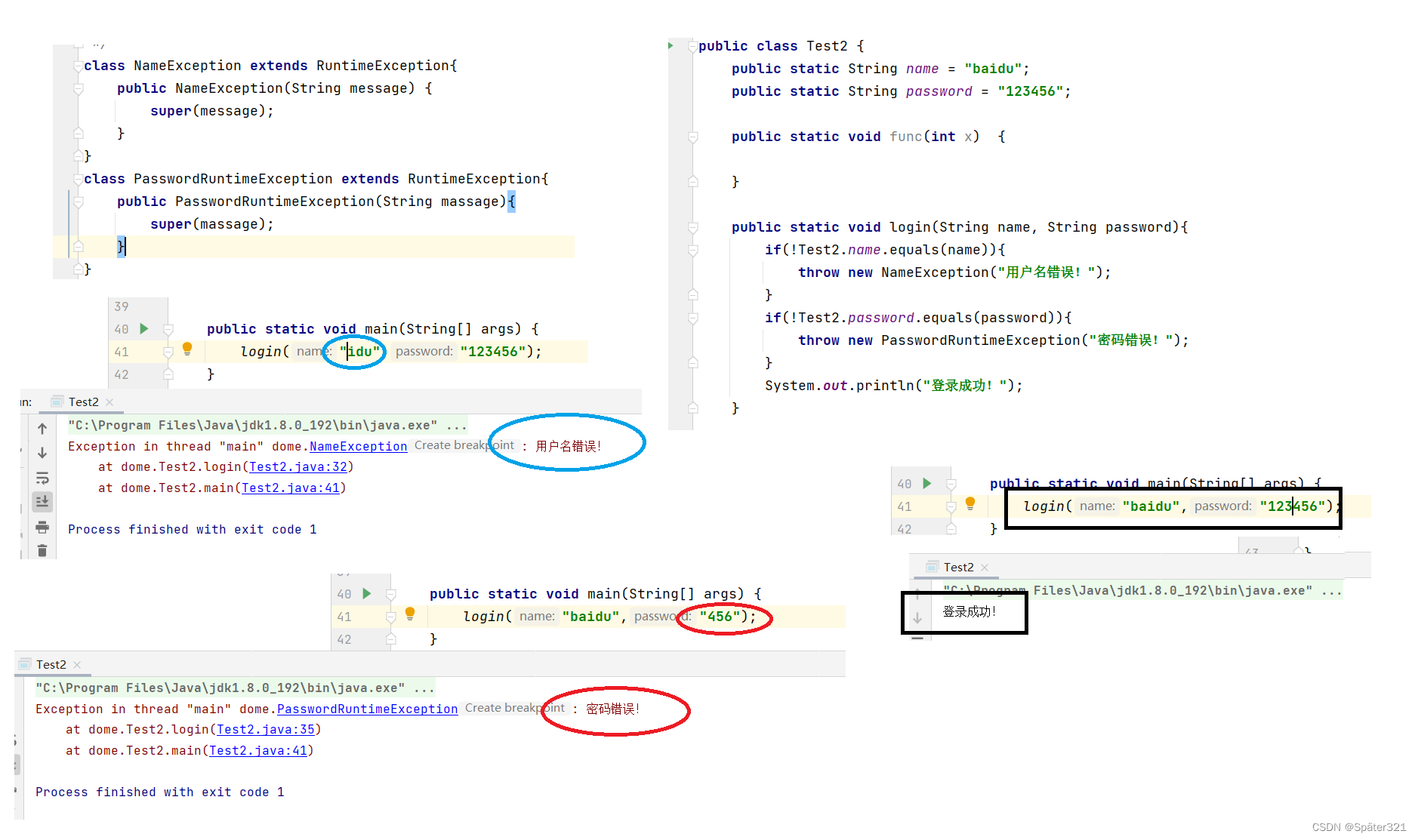
4.1、注意事项
- 自定义异常通常会继承自 Exception 或者 RuntimeException
- 继承自 Exception 的异常默认是受查异常
- 继承自 RuntimeException 的异常默认是非受查异常
